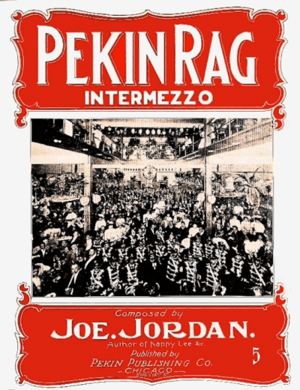Pekin Theatre facts for kids
|
|
 |
|
| Address | 2700 State Street Chicago, Illinois United States |
|---|---|
| Type | Black-owned theatre |
| Genre(s) | Musical theatre, vaudeville |
| Capacity | 1200 |
| Construction | |
| Opened | 18 June 1904 |
| Renovated | 1906 |
| Closed | After 1920 |
| Demolished | 1946 |
The Pekin Theatre in Chicago opened on June 18, 1904. It was the first theatre in the United States owned by Black people that focused on musical shows and vaudeville. From 1904 to about 1915, the Pekin Theatre was a special place. It helped train and show off the talents of Black actors, singers, and comedians.
The theatre also gave Black artists a chance to learn about theatre work. They could help create a new tradition of Black theatre. The Pekin Theatre was known by different names, like the "Temple of Music." It became famous for its all-Black acting group and a school for actors. Its orchestra could play many types of music, from ragtime to opera. They also put on new musical comedies.
Robert T. Motts started the theatre and made it very popular. He featured an all-Black company and welcomed audiences of all races. He also used his theatre to support important social causes. Motts passed away in 1911. After that, the theatre became less famous, but he had already set a new example for successful Black businesses.
Contents
History of the Pekin Theatre
After a trip to France in 1901, Robert T. Motts was inspired. He had seen the "Cafe Chantants" music halls in Paris. Motts, a businessman in Chicago, wanted to help his community. He aimed to provide entertainment that was more cultural and uplifting.
In 1904, he changed his Pekin saloon and restaurant into the Pekin Theatre. It was located at the corner of 27th and State Street. He called it the "Temple of Music." In 1906, a fire damaged the building. Motts rebuilt and improved the entire theatre. He increased its seating from 400 to 1200 people. This included special box seats.
The 'New Pekin Theatre' reopened on March 31, 1906. It had its own group of Black artists. They performed original musical comedies, funny plays, and dramas. These shows were written and composed by Black creators. The first show was a musical called The Man from 'Bam.
Motts hired many skilled people for his theatre. These included Charles Sager as stage manager and J. Ed Green as producing director. Joe Jordan was the music director. The Pekin Theatre became the "only theatre in America playing colored artists exclusively." This was important because many people at the time did not believe Black people could manage theatres well.
The Pekin Theatre had an all-African-American staff of 18 people. This included a press agent, a treasurer, and a house doctor. Its acting group, the Pekin Stock Co., had 34 members. Motts did not charge for tickets to the shows. Instead, he made money from the drinks sold during performances.
The Pekin Theatre became a key part of the Bronzeville area, known as "the Stroll." By 1910, there were over 53 Black-owned theatres across the United States. Seven of these were even named after Robert T. Motts' New Pekin Theatre. For example, the Old Crown Theatre in Boston changed its name to the Pekin.
Why the Pekin Theatre Declined
Over time, people became less interested in vaudeville and stock theatre. New forms of entertainment, like movies and nickel shows, became popular. Also, more white-owned theatres opened in Bronzeville, Chicago. Despite these challenges, the Pekin Theatre did well while Motts owned it.
It thrived until his death in 1911. Many people attended his funeral, showing how much he was respected. After Motts passed away, the Pekin Theatre was owned by his family for a while. Then it was sold to different owners over the next ten years. It never became as famous as it was when Motts was alive.
In 1912, two movie projectors were added to the theatre. Films like The Railroad Porter were shown when live plays were not scheduled. This continued until 1915. Around 1917, during the World War I era, the theatre became a dance hall. Jazz musicians like King Oliver played there.
Eventually, the building became the Pekin In Third District police station and jail. In 1946, the building was torn down. This was to make way for a housing project on the Southside of Chicago. Today, the site is mostly parking lots and the Dearborn Homes.
Famous Performers at the Pekin
Many talented actors, writers, and directors helped make The Pekin popular. Motts chose the performers carefully. He made sure there was no rude or inappropriate content in the shows. Many performers who started at The Pekin later became very famous.
- Charles Sidney Gilpin
- Jesse A. Shipp
- Harrison Stewart
- Lottie Grady
- J. Ed Green
- Lillyn Brown
- Miller and Lyles
- Andrew Tribble
- Aida Overton Walker
Booker T. Washington, a famous leader, also attended performances. He even gave a speech from the stage of the Pekin Theatre.
Legacy of the Pekin Theatre
In 2017, a special event called "An Evening at the Pekin Theatre” was held. It was a one-night show that brought back the spirit of the theatre. The Illinois Humanities Council presented it. Reginald Robinson, a ragtime musician who won a special award, performed there. A Chicago historian named Tim Samuelson also led walking tours of the Stroll area.
See also
- African Grove Theatre an African American owned live company specializing in drama that existed in 1820s New York City.


